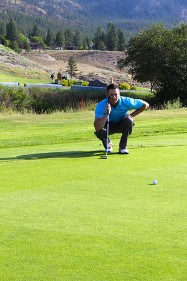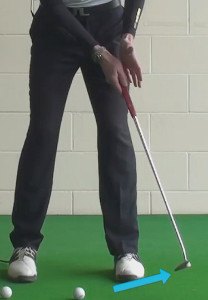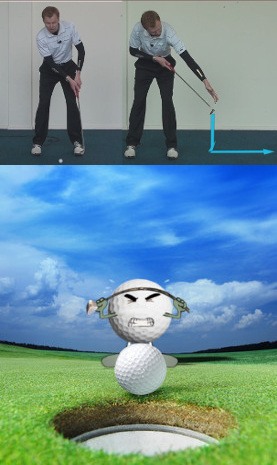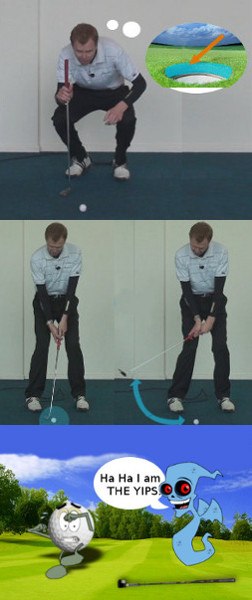
Pulling putts is a common malady, even among tour pros, especially on attempts from inside five feet. A decelerating putter is the cause of most pulls.
That is, the putter head slows down during the forward stroke, the face closes too early and the ball wobbles weakly to the left (for a right-handed golfer). The “decel” happens most often on short putts over fast greens, when fear of smacking the ball too far causes the stroke to break down.
Here's an incontrovertible truth: A putt that doesn't reach the hole will not go in. In fact, studies show that golfers should putt the ball with enough pace to send it 17 inches past the cup.
In other words, deceleration must be cured to ensure putting success.

One helpful mental hint is to simply aim for a spot beyond the hole, on the same line, and stroke the putt to hit the spot. A backstroke that's shorter than the forward stroke is also recommended to promote acceleration through the ball.
It helps to be brave. Try to knock short putts into the back of the cup, rather than dying them over the lip; just be sure to play less break when you stroke it firmly.
Thomas Golf Putters
Traditional, Mid-Length/Belly & Long Putters

Decelerating Stroke Causes Many Putting Ills
Do you struggle to perform consistently on the greens? If so, don't despair – you certainly aren't alone. While it might look like the easiest part of the game, putting is actually one of the most difficult things you are asked to do on the course. It takes a combination of skill, practice, and focus to consistently roll the ball nicely up toward the cup. Even when you do hit a great putt, you still have to hope that your read was good in order for the ball to fall in. There is a lot that can go wrong, and it is easy to get frustrated when you struggle to take care of business on the greens.
Unfortunately, there are countless ways in which things can go wrong when putting. You might struggle to read the greens accurately, or you may have a stroke which cuts across the ball at impact. No matter what the issue is, it will need to be corrected before consistent results can be achieved. Putting is too difficult to get away with a glaring mistake and still arrive at a positive outcome.
In this article, we are going to talk about one of the most-common putting errors in the amateur game – decelerating through impact. If you have a decelerating stroke, you are slowing the club down as it moves through the ball, which is a big mistake. The putter should at least be maintaining its speed, if not accelerating slightly, when you make contact. Decelerating through the ball is going to open you up to a whole world of negative outcomes, which we will take a closer look at later in the article.
If you hope to improve your putting, the first thing you need to do is take ownership of the situation. As silly as it might sound, some golfers just resign themselves to the fact that they will have some good days on the greens, and some bad days. It doesn't have to be like that. If you are willing to put in some work on the practice green, and you are willing to pay attention to the small details, you can perform well on a regular basis. Are you ever going to make all of your putts? No – of course not. Putting is hard, and you are going to miss plenty of putts along the way. However, putting is no different than any other area of the game in terms of rewarding hard work. If you practice the right techniques, you should see improvements almost immediately.
All of the content below is based on a right-handed golfer. If you happen to play left-handed, please take a moment to reverse the directions as necessary.

The Negative Impact of Deceleration
As mentioned above, decelerating the putter through impact can do a number of bad things to your performance on the greens. In this section, we are going to highlight some of the main issues that will pop up when you are decelerating through the ball with the flat stick. It is important to understand what issues can come from this mistake, as you will then be able to watch for them as you play. If one or two of the common signs of deceleration start to appear in your game, it may be necessary to get to work on correcting your fundamentals.
The list below highlights the common problems seen by those with a decelerating stroke.
- Leaving your putts short. This one is obvious. If the putter is losing speed through the hitting area, it is very likely that you are going to leave the putt short. Of course, coming up short is a particularly frustrating mistake to make, especially if the putt had the right line to fall in the hole. While it is foolish to say that you can never leave a putt short – such an attitude is sure to result in hitting your putts too hard – you definitely want to give the ball a chance to fall in whenever possible. By fixing your deceleration problem, you should be able to roll the ball the proper distance more times than not.
- Missing to the right. As a by-product of decelerating the putter through the ball, you may leave the blade open at impact. In a proper putting stroke, the face of the putter is going to gradually close as it approaches the ball, hopefully finding its way into a square position right as you make contact. However, when you let the club decelerate, the blade is likely to hang open and push the ball out to the right. This is why you will tend to miss on the right side of the hole when you are nervous – a tentative stroke is always likely to produce a right-side miss. If you can convince yourself to keep the putter moving at a steady pace, you should be able to square the blade and find your target line once again.
- Poor quality of contact. It is hard to contact the ball with the sweet spot of the putter when you decelerate your stroke. Often, you will miss low on the face when this happens, but the miss can take place anywhere, depending on the mechanics of your stroke. To achieve a solid hit, do your best to keep the putting moving all the way through the ball and into your finish. While most golfers think about making solid contact as a challenge that relates to the full swing, it is just as important when putting. If you can achieve contact on the sweet spot time after time, many of your other putting issues – such as speed control and hitting your target line – will disappear.
- Struggles under pressure. This was mentioned briefly above, but it deserves its own discussion because of the importance of the topic. Golf is a game that causes you to feel pressure from time to time, and how you are able to perform under that pressure will determine your score in the end. While it might be possible to achieve decent results with a decelerating stroke in practice, using this kind of stroke under pressure is a recipe for failure. The nerves that you feel when putting under pressure are going to get in the way of making your decelerating stroke work successfully. You can't do anything to eliminate nerves on the golf course, but you can improve your technique to the point where your nerves aren't able to totally take apart your game.
A decelerating putting stroke is not an asset to your game. You may make a few putts along the way with this kind of technique, but it shouldn't be relied on for consistent results. The sooner you can improve your mechanics to produce an accelerating stroke, the sooner you can lower your scores. The rest of this article will be dedicated to helping you take this faulty technique out of your game once and for all.

The Causes
So, what causes you to decelerate the putter in the first place? This is an important part of the discussion, as you can't fix the problem without knowing where it comes from. Once you understand the underlying issue, you can then address that issue in order to make improvements in your technique. Too many golfers rush into their practice sessions without stopping to think about the root cause of their issues – whatever those issues may be. You always need to understand a problem before you can fix it, and this problem is not different.
The list below highlights three common causes of a decelerating putting stroke. Think about these points in relation to your own game and decide which of these causes (if any) is at the heart of your putting struggles.
- A long backstroke. Without a doubt, this is the leading cause of a decelerating putting stroke. As you make your backstroke, it is easy to let the putter just continue on moving back away from the ball – even if it is already back far enough to create the power needed for the putt at hand. For most putts, you don't need all that much force to send the ball to the hole. That means you don't need a very long backswing. If you do make a long backswing, you will have no choice but to decelerate on the way through the ball. Combining a long backstroke with an accelerating forward stroke would surely send the ball zooming past the hole. Learning to manage the length of your backstroke properly can be a big help when it comes to producing an accelerating stroke that leaves you with just the right amount of power. While it is possible to make this mistake on any putt, it is particularly common to use too much backstroke on a short putt. Often, amateur golfers will attempt to handle their short putts with a combination of a long backstroke and a decelerating forward stroke. This is exactly the opposite of the technique you should be using. By making a short backstroke instead, and pairing it with an aggressive forward stroke, you can start the ball on line and hit it an appropriate speed as well.
- Lack of confidence. Sometimes, a decelerating putting stroke has nothing to do with your mechanics. In many cases, it comes down to a lack of confidence. If you don't believe in your ability to make putts, you may 'guide' the putter through the hitting zone, slowing the putter down as you go. Just like any other area of the course, you need to have a high level of confidence on the greens. By spending plenty of time practicing your stroke, you should be able to create confidence that you can use to your advantage during actual rounds of golf. Any time you feel your confidence slipping, get back to work on the practice green and make as many putts as you can to remind yourself what it feels like to be successful.
- An abbreviated follow through. The follow through is always an important part of your technique, no matter what kind of shot you are trying to hit. With regard to putting, you obviously aren't going to follow through all the way up over your head, like you would when hitting a driver. You still do need to follow through, however. Swing the putter cleanly through the ball, and keep it moving for at least a few more inches (depending on the length of the putt you are hitting). As a good rule of thumb, you should mirror your backstroke with your follow through. So, if you swung the putter a foot back from the ball, you should also swing it through a foot beyond the point of contact. You don't need to be too precise with this concept, but it will at least give you a frame of reference for creating an appropriate follow through.
Most likely, if you are currently having trouble with a decelerating putting stroke, the cause of your struggles can be found in the list above. For a large percentage of golfers, that first point – making a long backstroke – is going to be the culprit. However, plenty of players also struggle with low confidence and a short follow through, so think carefully about your putting issues and determine which cause is to blame.






